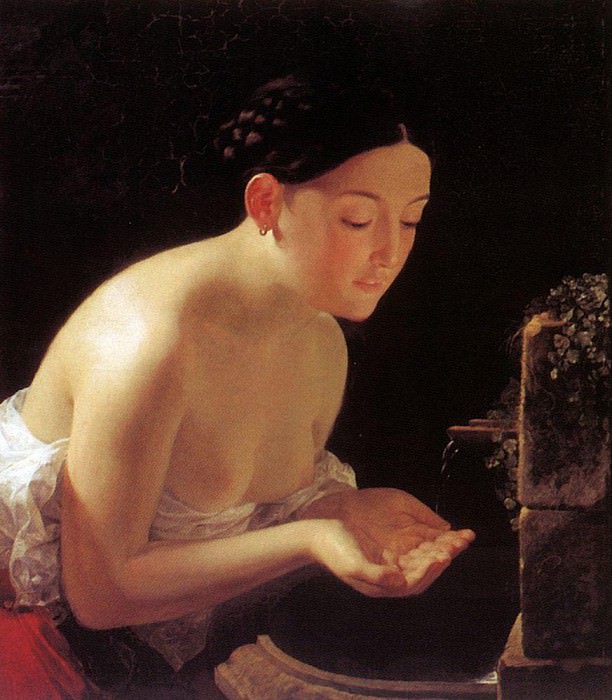Italian morning. 1823 Karl Pavlovich Bryullov (1799-1852)
Karl Pavlovich Bryullov – Italian morning. 1823
Edit attribution
Download full size: 873×1000 px (0,1 Mb)
Painter: Karl Pavlovich Bryullov
In 1822, after the establishment of the Society for the Encouragement of Artists, Karl Bryullov had the good fortune to become one of the Society’s first pensioners in Italy. Abroad, having visited the workshops and absorbed the achievements of the greatest masters of all times, he becomes one of the best painters in Rome. Carl Bryullov, with his work "Italian Morning," presents the viewer with a portrait of a young Italian woman making her morning toilet.
Description of Karl Bryullov’s painting "Italian Morning"
In 1822, after the establishment of the Society for the Encouragement of Artists, Karl Bryullov had the good fortune to become one of the Society’s first pensioners in Italy. Abroad, having visited the workshops and absorbed the achievements of the greatest masters of all times, he becomes one of the best painters in Rome.
Carl Bryullov, with his work "Italian Morning," presents the viewer with a portrait of a young Italian woman making her morning toilet. The canvas is filled with modesty, femininity, innocence and gentle sophistication. The girl is caressed by the morning sunlight, it shades her face and breasts. She is totally focused on her toilette and doesn’t notice the author.
The background of the painting is darkened, thus the artist allows the audience to see the girl clearly, noticing everything down to the smallest detail. The young Italian is full of charm and natural beauty: she has puffy lips, a regular nose, and under the lowered eyes, framed by thick and lush lashes, you can see the black eyes.
Karl Bryullov was able to achieve faithful color combinations, very realistically conveyed the texture of the water, the skin tone of the southern beauty.
Small details, such as a small shining earring, made the image of the Italian woman attractive and warm. Everyone raved about the canvas - first the Italian and then the Russian public. It was presented to the Russian Emperor Alexander I. The painting received a positive review in the Russian journal Otechestvennye Zapiski and the admiration of a whole pleiad of Russian painters.
Continuing to compare and unravel the complex mysteries of nature and man, as well as experimenting with light, Karl Bryullov, following the canvas "Italian Morning," would write the painting "Italian Noon," which summed up the many years of searching of the great Russian artist.
Кому понравилось
Пожалуйста, подождите
На эту операцию может потребоваться несколько секунд.
Информация появится в новом окне,
если открытие новых окон не запрещено в настройках вашего браузера.
You need to login
Для работы с коллекциями – пожалуйста, войдите в аккаунт (open in new window).




















COMMENTS: 1 Ответы
Напомнила Монику Беллуччи
You cannot comment Why?
The subtexts of the painting can be interpreted in several ways. The title, Italian morning, immediately sets a scene of a simple, perhaps rural, Italian life during a fresh new day. The act of collecting water from a fountain is a timeless, almost archetypal image, representing essential sustenance and purity. The womans pose, with her head bowed and eyes downcast, and her partially revealed form, can evoke a sense of modesty, innocence, and natural beauty. The gentle cascade of water might symbolize purification or the fresh start of a new day. The contrast between the natural elements – the water, the greenery, the implied outdoor setting – and the womans delicate form creates a harmonious and serene atmosphere. Theres a quiet intimacy and a sense of unadorned beauty in the scene, a moment of personal ritual before the day begins in earnest. It could be seen as an ode to simple pleasures, natural beauty, and the quiet dignity of everyday life.